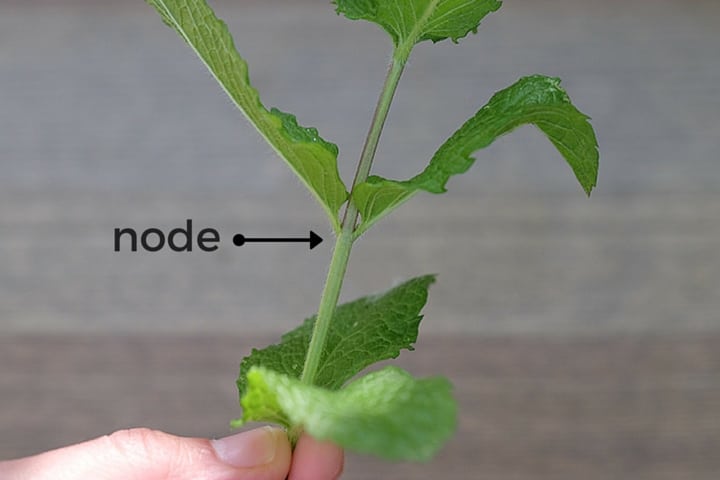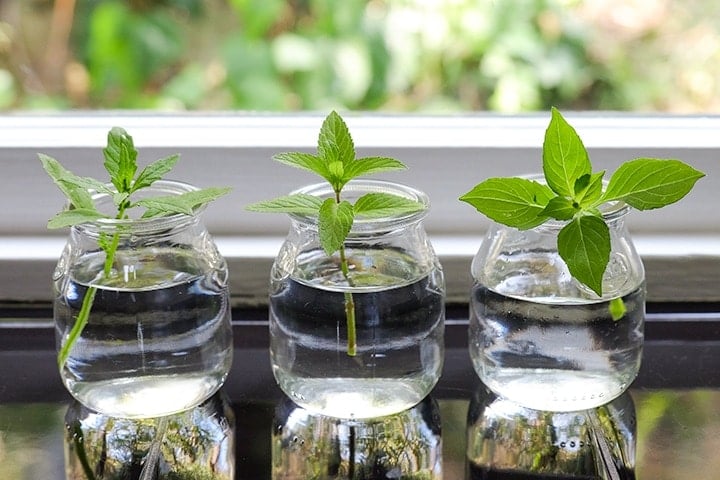From a scattering of basil on healthy greens pizza to a handful of mint in a pitcher of iced tea, fresh herbs make our meals shine. More than just garnish, herbs like basil and mint provide a punch of flavor, nutrients, and healing properties.
Fresh herbs can get expensive, though, whether you’re buying cut herbs at the market or planting an herb garden. By propagating or cloning herbs from cuttings, you can save money, turning one plant into an infinite supply of new ones.
Growing herbs from cuttings also saves time because it’s faster than growing herbs from seed. For those who don’t have garden space, this can be a fun way to grow herbs indoors all year round, close to the kitchen where you’ll use them.
It’s super simple. All you need is a cutting from an herb plant and a glass of water…
Herbs You Can Root in Water
This easy propagation technique involves snipping a stem from a mature herb plant, putting the cutting in water, and waiting until it grows new roots. You can keep growing the herb in water indoors, or transplant it to soil in the garden.
Rooting in water works especially well for soft-stemmed herbs such as basil, mint, lemon balm, oregano, and stevia. For woody herbs like rosemary, sage, oregano, and thyme, take cuttings from new, green growth; older brown stems do not sprout roots easily.
Note that some annual herbs like parsley, cilantro, and dill should be grown from seed and do not work with this method.

Where to Get Herb Cuttings
There are lots of places to get cuttings, from mature plants in your own garden to friends’ and neighbors’ gardens (with permission, of course!), and even herb sprigs that you buy at the grocery store or farmers’ market.
For best results, take cuttings from healthy, disease-free plants in spring or summer. Avoid cutting herbs that are actively flowering because you want the plant’s energy to be focused on forming roots, not flowers. If you do take cuttings from a flowering plant, be sure to pinch off any flowers before you root it.
How to Grow Herbs from Cuttings in Water
Save money and time by growing herbs from cuttings and turn one plant into an endless supply of new ones.
What you’ll need…
- Sharp knife or scissors
- Rubbing alcohol
- Clean glass or jar (see Notes)
- Room temperature water (see Notes)
- Pebbles (optional)

1) Clean your tools. Clean your knife or scissors in warm, soapy water and wipe with rubbing alcohol to sanitize.

2) Take a cutting. Using a clean knife or scissors, take a stem cutting about 4 to 6 inches long. Make the cut at an angle, just below a leaf node (the point on a stem from which leaves grow). If you’re using cut herbs from the store, make a fresh cut at the bottom of the stem. It’s a good idea to take a few cuttings to make sure at least one of them will root.

3) Trim the cutting. Remove the leaves from the lower two-thirds of the stem; this is so they don’t get submerged under the water and rot. Also snip off any flowers, buds, or large leaves so the plant’s energy gets directed toward making roots. Take care not to cut or damage the stem as you’re removing leaves. (Tip: Use the extra leaves to make tea!)

4) Put the cutting in water. Stand the cutting in a glass of water, making sure the topmost leaves have plenty of airflow and no leaves are submerged in water. Keep the jar in warm place with plenty of indirect light.
5) Change the water frequently. Change the water every day or two to prevent the growth of algae and bacteria.

6) Wait for roots to grow. Depending on the plant and conditions, rooting time may take a couple days to a couple weeks.
Once the roots appear, you can keep your plant growing in water and just snip off leaves as you need them. As the plant grows, you may need to transfer it to a bigger vessel.
Or, you can transplant it in the garden:
7) Harden the roots (optional). If you’re planting herbs in soil, it’s a good idea to toughen the roots first. To help them harden, drop small pebbles onto the roots each day for a week.
8) Transplant (optional). When the roots are 1 to 2 inches long, plant it in the garden or a container of potting soil.
Notes
- Glass or jar: Choose a glass or jar with room for airflow around the leaves. Algae grows faster in clear glass and more slowly in opaque or amber glass, but if you change the water frequently (see Step 5), then algae shouldn’t be a problem.
- Water: Filtered water and spring water are good choices. Avoid distilled water, which lacks important trace minerals, and chlorinated water, which may hurt plant tissues. You can also leave chlorinated tap water out for 24 hours to let the chlorine evaporate.










I cannot tell you how often I’ve wanted fresh herbs for a recipe only to realize I have no garden. Tough to grow herbs in North Las Vegas. Now you have given me the tools. I am now on a mission to grow my own indoors.
I will keep you updated.
Thank you.
Thanks for commenting, Nena! Good luck, and let us know how it goes.
I like to put a splash of raw unfiltered apple cider vinegar into the water to supply minerals to the cuttings.
Cool, I’ll have to give that a try!
Nice idea.. Going to try with lemon balm soon…
This will be a great way to have holy basil all winter!!!!
great to know that I don’t need dirt but isn’t there nutrients in soil that’s needed?
Spring water typically has enough minerals for the plants to grow. Just be sure to avoid distilled water.
i use an aquaponics inspired setup indoors, which pumps aquarium water underneath my plants (part herbs part vegetables). so not onlt do my plants have a continous source of water and fertilizer, they also clean my aquarium.
How have you set that up? I’d love to see pictures
Neat! I’m going to try it. Thank you.
That’s a wonderful idea using aquaponics and hooking it to your aquarium! Would love to see a picture of how you do that!
What a great idea Emily, I will be trying these!
I have tried starting a curry leaf plant using this method with cuttings from the market.. sadly without success. Is this a viable method of propagating that plant?
I haven’t tried propagating curry plants (I’m assuming you mean Murraya koenigii?), but I wonder if they would root better in a soilless potting mix rather than water.
This was so interesting. I have lots growing outside, but to ha e them also growing in the kitchen on hand and so easy to grow, is great. Thank you so much for sharng.
What perfect timing! I just got my first home with a kitchen window perfect for growing herbs. I will definitely give this a try. Thanks for the great instructuons.
Thanks, Emily! I’ll give this a try.
Can you do this with lavender plants? I have such trouble growing/keeping my lavender plants alive and healthy. If I could do sprigs in water, that would be awesome!
I haven’t tried growing lavender in water; my understanding is that it works better in soil. Try a google search for “propagating lavender” for tips!
I tried this in water with my mint plant, it grew but as soon as it was ready to be transferred and after the transfer it didn’t look as strong as it did in the water. I’m still watching it closely. .. Is it possible to just let it continue to grow in water?
I’ve found that they can usually keep growing in water for 6-12 months or so – and if you keep making and rooting more cuttings, you’ll have a never-ending supply :)
I have some herbs that are growing in an area that unfortunately had to be treated for termites, so I haven’t been using them at all. I have been wondering … if I rooted cuttings from these plants in water, would the new growth from that cutting be free of the pesticide? I would rather think so, but I’m not sure, so I haven’t.
If your plant and equipment are clean, its better to not replace the water regularly. I have always been told that the plants release a hormone once they start rooting, which encourages further rooting. Using water from previously rooted plants helps the next batch root faster. It seems to hold up for me – at least, I have never had a problem with bacteria growth.
Maybe try this one: http://inhabitat.com/ikea-launches-indoor-garden-that-can-grow-food-all-year-round/ the first batch of seeds contain a lot of lettuce and herbs.
I just planted some herbs in my edible landscaping! I am going to try this out. Thanks for all of the great tips!
Can anyone place that scissors shown above?
The garden shears are from Burgon & Ball.